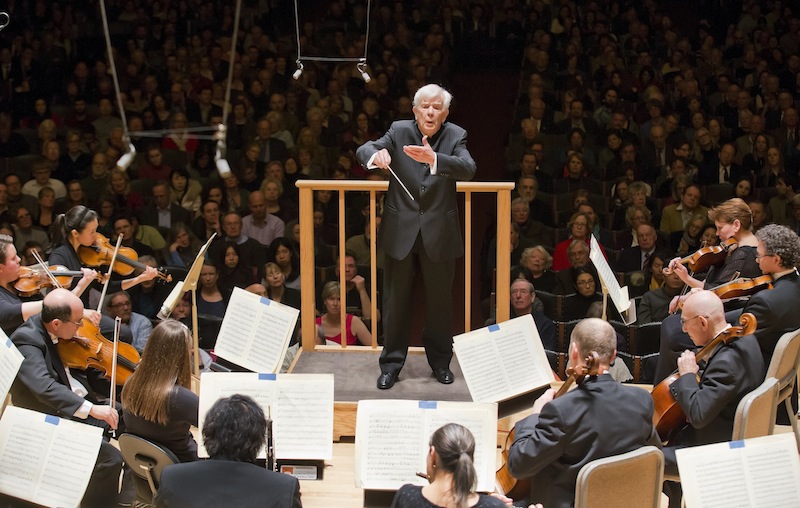Dohnányi, BSO offer vigorous account of Mozart’s symphonic triptych
Although each of Mozart’s last three symphonies is a familiar item in its own right, it’s important now and then to perform them all in a single concert, one after another. That’s the way the composer wrote them, in just a few weeks during the summer of 1788, and taken together they form one of the summits of human accomplishment in music.
The Boston Symphony Orchestra and guest conductor Christoph von Dohnányi climbed that peak with energy and determination Thursday night. The weather was fine, the air was bracing, and the view from the top was awe-inspiring.
Mountain guide Dohnányi generally set a brisk pace, with faster-than-average tempos and a rock-steady beat that admitted no lolly-gagging. Instead of pausing to admire each Mozartean inspiration as it went by, the conductor linked the ideas into long thoughts, culminating in the famously fugal finale of the Symphony No. 41 in C major (“Jupiter”), where a fistful of mini-themes were stirred together in a contrapuntal free-for-all.
In this, and in the orchestra’s lean sound with prominent winds, Thursday’s performances seemed informed by the current crop of period-instrument bands, with their up-tempo renditions that, in theory at least, “let Mozart be Mozart” without added layers of interpretation.
Still, the glory of this tripartite opus is its diversity, and one wouldn’t have minded hearing the Symphony No. 39 in E-flat major warmed and jollied up a bit to bring out its Haydn-to-early-Beethoven character, or No. 40 in G minor brooding and seething more with its barely suppressed violence, or the opening theme of the “Jupiter” swelled to Olympian grandeur—the better to puncture it a few seconds later with Mozartean laughter in the winds.
But if Dohnányi didn’t take full advantage of this orchestra’s stylistic versatility on the large scale, he did ask for and get a wonderful variety of instrumental timbres and blends to suit the mood of the moment. Strings, for example, could put a full, cushiony sound under the winds in the first movement of No. 39, dance lightly in that work’s Andante con moto, and lash out in the aggressive minuet theme of No. 40.
The performances showcased Mozart’s endlessly inventive writing for winds, more for color than for conspicuous solos—although Michael Wayne’s charming turn on clarinet in the trio of No. 39’s minuet deserves mention. Personnel in this section rotated in and out between symphonies, but the results were consistently high as the woodwinds gathered like birds in a tree for a crescendo, gently oiled a transition, roared like an organ or engaged the strings in tender dialogue. Appropriately, during bows at the concert’s close, Dohnányi had the section stand up not individually but all together.
Despite the conductor’s speedy tempos, this evening of three relatively compact Classical symphonies (plus one generous intermission) stretched out to a full two hours, and one wouldn’t want a minute of it back. Dohnányi took nearly all the indicated repeats—including the often-omitted ones in the return of the minuet after the trio—and if he didn’t vary them much, one was grateful for the opportunity to savor the orchestra’s fine craftsmanship again or catch an unnoticed detail as the music sped by.
The conductor made a few subtle adjustments to his one-movement-one-tempo approach, relaxing the pace just slightly for the tender trio of No. 40’s hard-driving minuet, for example, or for the pleading second theme of that symphony’s ruthless finale. Most of the time, however, momentum was the rule, as when he kept the elaborate slow movement of No. 39 dancing all the way to its close, or flung the counterpoint together in a headlong finale to No. 41.
Audience response is hard to analyze, but the obligatory standing ovation at concert’s end seemed a bit slow to bloom, as if the audience wanted to show its appreciation for the orchestra’s fine playing and the 85-year-old conductor’s fortitude, but perhaps not for having experienced Mozart’s greatness at full impact. No matter—an evening with world-class performers and this musical landmark of Western civilization is an evening well spent.
The program will be repeated 8 p.m. Friday (an “Underscore Friday” concert with introductory comments by BSO principal double bassist Edwin Barker) and 8 p.m. Saturday. bso.org; 617-266-1200.
Posted in Performances





